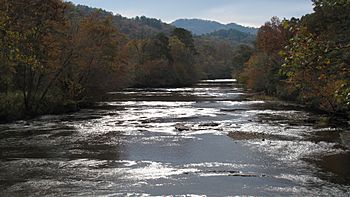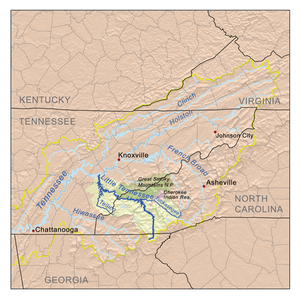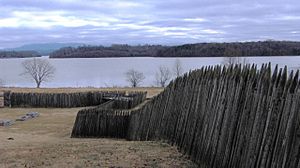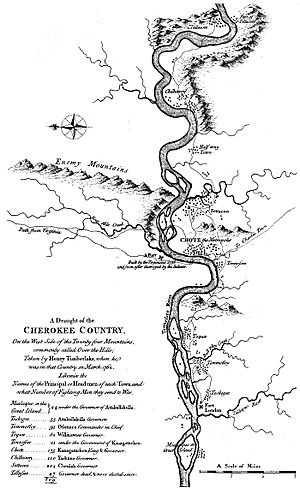Little Tennessee River facts for kids
Quick facts for kids Little Tennessee River |
|
|---|---|

Little Tennessee River in North Carolina
|
|

Little Tennessee River watershed
|
|
| Country | United States |
| State | Georgia, North Carolina, Tennessee |
| Physical characteristics | |
| Main source | Keener Creek Rabun County, Georgia 3,240 ft (990 m) 34°57′36″N 83°27′53″W / 34.96000°N 83.46472°W |
| 2nd source | Billy Creek Rabun County, Georgia 2,640 ft (800 m) 34°55′17″N 83°27′04″W / 34.92139°N 83.45111°W |
| River mouth | Tennessee River Lenoir City, Tennessee 741 ft (226 m) 35°46′57″N 84°15′28″W / 35.78250°N 84.25778°W |
| Length | 135 mi (217 km) |
| Basin features | |
| River system | Tennessee → Ohio → Mississippi |
| Basin size | 2,627 sq mi (6,800 km2) |
| Tributaries |
|
The Little Tennessee River is a 135-mile (217 km) long river. It is a branch of the Tennessee River. This river flows through the Blue Ridge Mountains. It starts in Georgia, then goes through North Carolina, and finally into Tennessee.
The river helps drain parts of three national forests. These are Chattahoochee, Nantahala, and Cherokee. It also forms the southwestern edge of the Great Smoky Mountains National Park. Many dams were built on the river in the 1900s. These dams help control floods and create electricity. The river has five main dams: Fontana Dam, Cheoah Dam, Calderwood Dam, Chilhowee Dam, and Tellico Dam. There is also a smaller dam called Porters Bend Dam.
Where the River Flows
The Little Tennessee River starts in the Blue Ridge Mountains. It begins in the Chattahoochee National Forest in Rabun County, Georgia. It flows north through the mountains past Dillard. Then it enters southwestern North Carolina.
Near Franklin, it meets the Cullasaja River. The river then turns northwest. It flows through the Nantahala National Forest. This path is along the north side of the Nantahala Mountains. Finally, it crosses into eastern Tennessee. It joins the Tennessee River at Lenoir City. This spot is about 25 miles (40 km) southwest of Knoxville.
Dams and Reservoirs
The lower part of the river has several dams. Some of these were built by the Tennessee Valley Authority (TVA). They create a series of reservoirs (large artificial lakes). These lakes stretch from western North Carolina to eastern Tennessee. They go all the way to where the Little Tennessee River meets the Tennessee River.
Near the border of North Carolina and Tennessee is the Fontana Dam. It is 480 feet (146 m) tall and was finished in 1944. This dam forms Fontana Lake. This lake is along the southern edge of Great Smoky Mountains National Park. Other dams include Cheoah Dam in North Carolina. In Tennessee, there are Calderwood and Chilhowee dams. These reservoirs help control floods and make hydroelectric power (electricity from water).
Calderwood and Cheoah dams send water through short tunnels. This water then powers hydroelectric generators. The Chilhowee Dam has power generators built right into the dam. Some water also comes from the Santeetlah Dam on the Cheoah River. This water powers another generator at the Santeetlah Powerhouse. It travels through 7 miles (11 km) of tunnels under the Great Smoky Mountains.
Chilhowee, Calderwood, and Cheoah Dams were first built by Alcoa. They provided power for an aluminum plant in Alcoa, Tennessee. Alcoa works with TVA to manage the dams. They make sure water levels are safe for boating and fishing. They also ensure proper water flow down the river.
The last dam is Tellico Dam. It is just before the river joins the Tennessee River. This dam creates Tellico Reservoir. The Tellico Dam does not make its own electricity. Instead, it helps increase water flow for generators at the nearby Fort Loudoun Dam. It does this using a canal that moves water from the Little Tennessee River.
Building the Tellico Dam caused a lot of discussion in the 1970s. This was because of the discovery of the snail darter. This small fish was an endangered species. This situation was one of the first big challenges to the Endangered Species Act.
River History
The Little Tennessee River area is very important for archaeology. It has many ancient sites where people lived. Some of these sites date back as far as 7,500 B.C. One expert, Cyrus Thomas, said it was the "most interesting archaeological section" in the whole Appalachian region.
Very old sites from the Archaic period (8000-1000 B.C.) are found along the river. These include Icehouse Bottom and Rose Island. These places were likely temporary camps. People living there may have used the chert (a type of rock) from nearby bluffs to make tools.
Evidence of people from the Woodland period (1000 B.C. - 1000 A.D.) has also been found. Many burial sites from this time were found on Rose and Calloway islands. Pottery pieces found here show that these people traded with the Hopewell people from what is now Ohio.
Mississippian period (around 1000-1500 A.D.) sites are also in the valley. These include Toqua and Citico. At Toqua, people built a 25-foot (7.6 m) tall platform mound. This mound overlooked a central plaza. By 1400, the village was about 4.8 acres (0.019 km2) and had a clay wall around it.
Several Cherokee towns were located along the upper Little Tennessee River. These included Nikwasi, Watauga, Jore, and Cowee. Mounds built around 1000 CE by earlier Mississippian people still exist at these sites.
The river was also central to many major Overhill Cherokee towns. Important towns included Chota, Tanasi, Toqua, and Tallassee.

European traders started visiting these Cherokee towns in the late 1600s. Some historians believe Spanish explorers Hernando De Soto and Juan Pardo traveled through this valley in the 1500s.
In 1756, the English built Fort Loudoun. It was located where the river meets the Tellico River. This fort was for defense during the French and Indian War. This war was part of a bigger conflict between England and France. The fort has been rebuilt as a historical site.
Two early American sites are also along the river. The Tellico Blockhouse was an outpost. Morganton was a river port and ferry town. It was very busy in the early 1800s.
Images for kids




